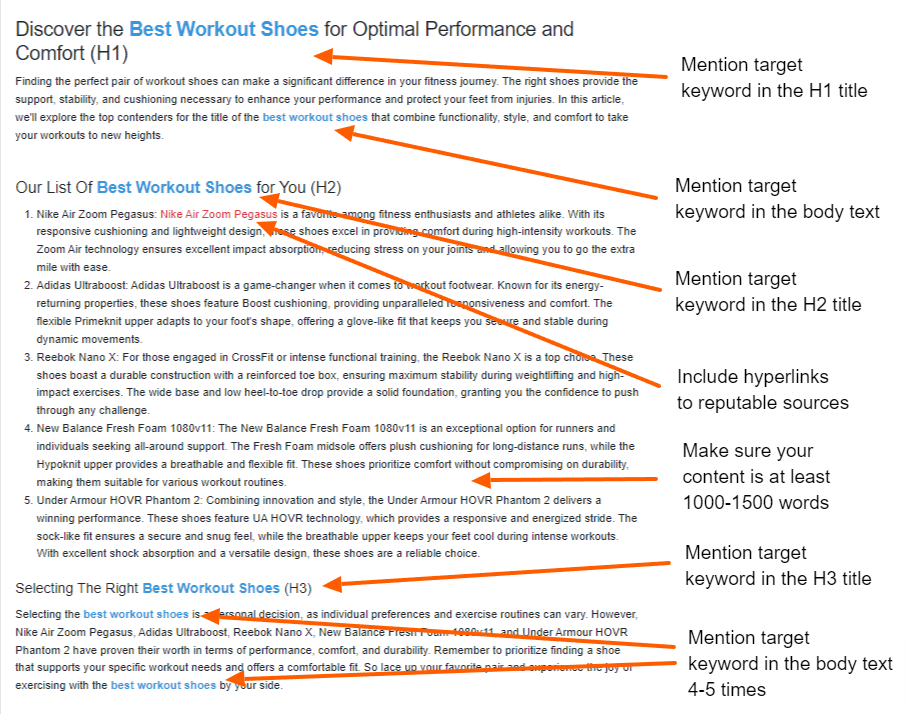Asking How to Write SEO Friendly Article in WordPress? Let’s learn and master the topic and start writing amazing SEO-optimized blog posts right away. In this article, we will share important points as well as tools to make your job easier and more efficient. Follow these steps, get a monthly backlinks service, and in no time you will gain thousands of organic traffic coming to your WordPress and blog site. Let’s go!
Beginning: How to Write SEO Friendly Article in WordPress
Let’s just assume that you are writing a blog post for the keyword “Best Workout Shoes” Here is an example article that is SEO optimized. Your target keyword should be in your H1, H2, and H3 titles as well as body text. In this example, you can see all the keywords are highlighted in the sample image below.

Key Points: How to Write SEO Friendly Article in WordPress
There are some key points on How to Write SEO Friendly Article in WordPress. These points may help your article to be more readable and SEO optimized. No worries if you are a beginner and trying to learn how to write SEO-optimized blog posts and eventually make an income out of it. Here are some of the key points you should be focusing on and if you need you always use the blog article SEO checker free tool for some guidance. If you get stuck and not sure what to do, you can always use blog content writing services to help you. Let’s dive in.
Keyword Focus Heading

This title above is an H3 title you should always include multiple H2 and H3 titles in your article. But DO NOT use the H1 title more than once! This is part of the best practice to use the H1 title once in your whole blog post. However, you can use H2 and H3 more than once. The reason is that H1 gives a hierarchy structure to the page while simplifying things for readers. Check the heading hierarchy structure.
Summary:
- Use H1 Once
- Use H2 multiple times
- Use H3 multiple times
- Use H4 at least once
Keyword Density
Keyword Density is the number of times your keyword appears in your article. The best practice is to mention the target keyword within the content 4-5 times. For example, if you have written a blog post/article that is 1500 words in total, it’s best to spread the keyword though out the content 4-5 times. However, if you have less than 1500 words then you should repeat the keyword less than 4 times. You do not want to do keyword stuffing which is not preferred by search engines.
Summary
- Spread the keywords evenly
- Don’t do keyword stuffing
- Mention the target keyword 4-5 times
Article Length
Having a quality article is better than having a quantity article. What I mean is that don’t just write 1500 words of article to match the requirement. That is to say, make sure your blog post is full of information that satisfies the user’s intent. Most importantly. do not write an article SEO first! It should be written for humans first and then optimize the content to be SEO-friendly. Having bullet points, educational facts, and images will help you to rank the article higher and keep user engagement on the blog post.
Also, it is important to practice EAT guidelines and display experience and expertise within your content with your knowledge. In other words, your article should present that whoever wrote the article has some experience with the topic. You cant just write super generic content and expect to be an internet sensation.
Summary
- Write for humans first
- Include stats, facts images
- Keep the content 1000-1500 words
- Write a quality article
- Satisfy the user’s intent
Helpful Hyperlinks
Let’s say there is a word or lingo that can not be understood by the user, you might want to hyperlink that word to its explanation. It will help the content to be more understandable and readable. If you have a couple of reputable hyperlinks within your content, it will indicate that the article has useful links to educate the users. Hyperlinks can also help Google indexing pages on your website, this is called internal linking.
There is an external linking as well, which is to link certain words within your content to reputable websites that offer detailed information on that specific subject. Both linking types will increase your SEO rating while helping user flow on your site.
Summary
- Use internal links
- Use external links
- Link to reputable sites
- Don’t send traffic to spammy sites
Add Images
Include images that represent your article and the titles within the content. Images are great for conversions and bounce rates. Images keep users’ attention on the content and help them better understand the context of the article and parts of the page. Also including Alt text in images may assist search engines identify the content and help you rank your article higher on search results.
Make sure to compress and use smaller-sized images to decrease the load time for desktop and mobile devices. Recent stats show that 55% of the traffic comes from mobile devices. Therefore, you need to keep your articles loaded super fast!
Summary
- Add related images
- Alt text images
- Compress images
Conclusion: How to Write SEO Friendly Article in WordPress
Find a topic you enjoy and try to write an article that answers questions that people are searching for. Make sure to follow these best practices to get your article ranked on search results. After publishing the blog post, use the Google search console to submit your article to be indexed by Google. If you are not sure how to do it, here is a video for Google Search Console Tutorial for Beginners that explains everything you need to know. Hope this article clarifies how to write an SEO-friendly blog post for your wordpress website.




